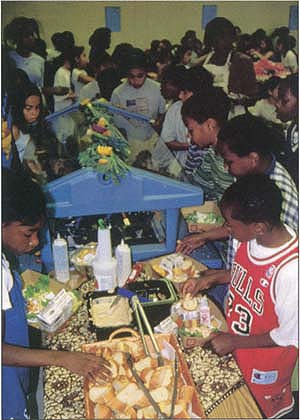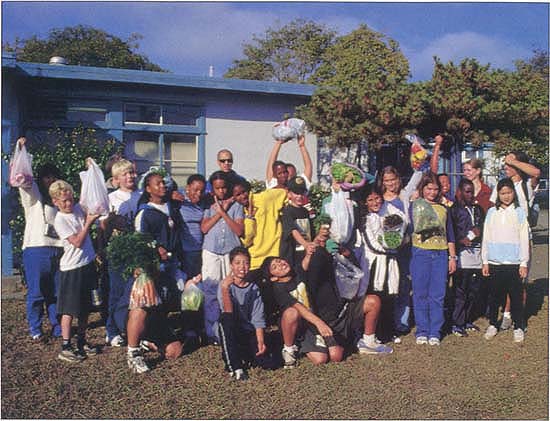All Issues
School gardens produce food and lessons
Publication Information
California Agriculture 54(5):10-11.
Published September 01, 2000
PDF | Citation | Permissions
Full text
Studies show that school gardens can be a powerful tool for teaching children about complex food and environmental systems ( see p. 48 ). As part of a 1995 initiative to put a garden in every school, the California Department of Education offers start-up information and grants to offset garden costs for nutrition education. Roughly 20% of the state's 8,000 schools have gardens so far.
UC's Sustainable Agriculture Research and Education Program (SAREP), which supports projects that work within the food system to build more sustainable communities, has helped fund several school garden projects around the state. One of the most successful of these is in Berkeley.
At the end of the 1999 school year, 15 out of 17 schools in the Berkeley Unified School District (BUSD) had school gardens. Six of those schools also produce vegetables for school consumption. SAREP funded the Willard Greening Project, a biointensive garden at the Willard Middle School that now supplies several schools with greens for their salad bars. The garden also offers an educational component for sixth-graders.
The success of the Berkeley project is partly due to a broad-based coalition of concerned citizens that has been meeting to improve the health of children and families in Berkeley. The Berkeley Food Systems Project (BFSP) is trying to increase the capacity of the school nutrition service to provide fresh, seasonal, locally grown foods to a greater number of school children; integrate curriculum with a garden in every school; and bring about policy changes that affect the long-term food security of regional food systems.
The salad bar at Malcolm X Elementary School in Berkeley is primarily supplied with fresh produce from farmers' markets, but is augmented with vegetables grown by the students in their own garden.
The BFSP was created in 1998 with funding from the Center for Ecoliteracy and the USDA's Food Projects Grant Program. Among its initial efforts has been the establishment of a BUSD Food Policy to guide the school nutrition service. The primary goal is to ensure food security for all of Berkeley's school children by providing healthy, nutritious, culturally appropriate meals including organic and locally grown foods, regardless of the students' ability to pay.
The food policy (see box) is one of the first nationwide that explicitly integrates health, food and sustainable agriculture as valid components of the schools' role. The school district's food service, which serves 17 schools and about 9,400 students, purchases food for its “farmers' market salad bars” from family farms that practice sustainable agriculture. The inclusion of fresh, locally grown produce improves the quality of the school meals while providing a much-needed market for area farms.
SAREP has been collecting data to evaluate the BFSP project.
Berkeley Unified School District Food Policy
“The BUSD Board of Education recognizes the important connections between a healthy diet and a student's ability to learn effectively and achieve high standards in school. The Board also recognizes the school's role, as part of the larger community, to promote family health, sustainable agriculture and environmental restoration. BUSD's educational mission is to improve the health of the entire community by teaching students and families ways to establish and maintain lifelong healthy eating habits through nutrition education, experiences in the garden and the food served in schools.”
“We saw a 46% increase in paying customers,” recounts Suzanne Bernhard, salad bar coordinator for the district. “Approximately 80% of the students eating in the cafeteria chose the salad bar over the regular hot meal.” Informal interviews with children indicated that they were very satisfied with the new food and meal format. “This food is ‘the bomb,’” raved one student; another said, “I've been begging my mom to give me lunch money so I could buy the salad bar.” In fall of 2000, three more salad bars are expected to open. School meal participation and consumption will be closely monitored. Jered Lawson, one of the BFSP coordinators responsible for bringing the farmers' market salad bar idea to the district, says, “With local, farm-fresh, organic produce, such as strawberries and carrots that have exceptional flavor, not to mention color, it's hard for students to resist.” Although the novelty is expected to wear off, similar programs in Southern California show a consistently higher participation level.
In the first 18 months of the Berkeley program, parents, educators and school food-service personnel have redesigned the school lunch menu to include more organic foods, a daily vegetarian choice and a fresh fruit or vegetable choice with every lunch. Expenditures on local produce rose from 0.4% to 4.8% of the budget. A monthly newsletter from the Child Nutrition Advisory Committee highlights food and nutrition topics for students and their parents. The committee will continue to provide suggestions and advice to the superintendent and food-service director about the quality of school meals. The goal is not only to provide a healthy, nutritious meal for students, but also to ensure that the meals are part of students' overall education about a secure and sustainable food system.
BFSP school garden coordinator Erica Peng works with teachers and individual coordinators to create a garden in every school, integrated with classroom curricula.
“The garden is a tangible way to teach students about the entire food system including production and environmental health, labor issues, processing, cooking and eating,” says Peng. It provides an opportunity for studying cycles, systems, water and waste recycling, and food and watersheds. Teachers can also use the garden to enrich state-mandated curriculum in math, history, science, literature, writing, art and music. Eventually, the BFSP will develop a district-wide food systems-based curriculum. The goal in such an integrated curriculum is to engage children in their food and ecosystem so they will carry that appreciation with them into adulthood.
Willard Middle School sixth-graders return from the farmers' market with produce for a cooking class with author and chef Mollie Katzen.
Since its inception, the BFSP has focused on identifying policy changes that would improve community food security for all Berkeley residents. Toward this end, they helped establish the Berkeley Food Policy Council, which is assessing the state of the local food system and providing an action framework for local government to address issues including hunger, nutrition and food access. In the last year, the Council made General Plan Recommendations to the city regarding food system issues. “We formed a working group that came up with an entire new ‘local food systems’ section in the plan that includes the promotion of food production in the city, more support for farmers' markets and direct marketing of regional produce,” Lawson explains.







